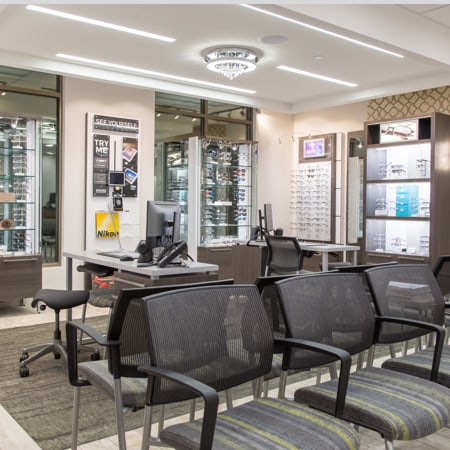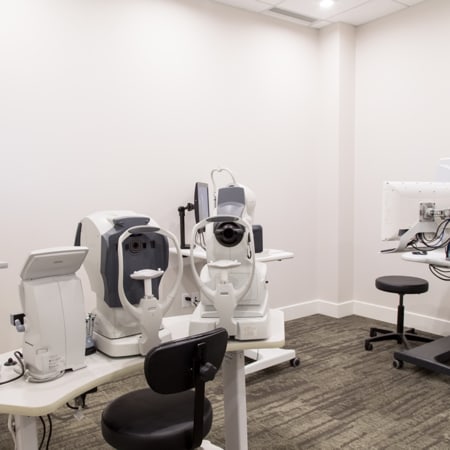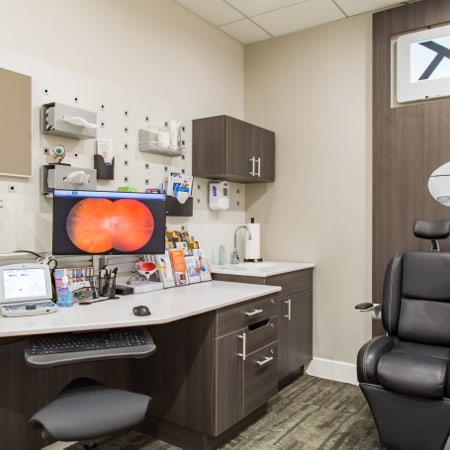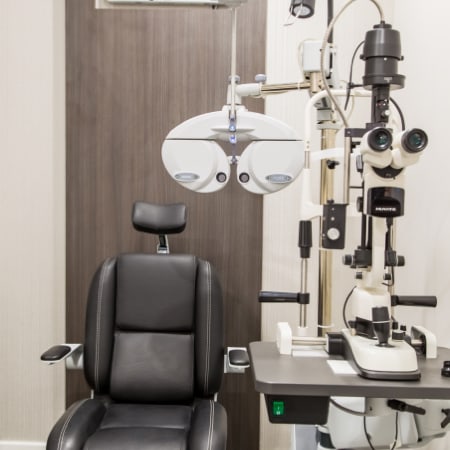If you or someone you love is diagnosed with glaucoma, one of your first questions may be, “What does glaucoma vision look like?” Understanding what eye diseases like glaucoma can do to our sight can help us prepare for how it might affect our lives.
At first, Glaucoma is often referred to as the “silent thief of sight” because it typically presents no obvious symptoms during its early stages, making eye exams crucial for early detection and treatment. Though, as the disease progresses, advanced glaucoma symptoms can include blurred vision, haziness, patchy vision, or diminished vision, and without proper treatment, it can lead to complete blindness.
The first signs of vision loss caused by glaucoma often begin with peripheral vision, so when you have glaucoma, your vision can start to look like a tunnel, with blind spots or complete blindness at the edges.
If you or a member of your family is at risk of developing glaucoma, routine eye exams are vital for monitoring your sight. Regular, comprehensive testing provides an opportunity to catch and manage glaucoma before it causes vision loss.
What Is Glaucoma?
You might be surprised to learn that glaucoma is a group of eye diseases, each of which can cause damage to your optic nerve, resulting in a loss of vision and, if left untreated, blindness.
The most common type of glaucoma is primary open-angle glaucoma, which occurs when the pressure inside your eye increases and damages your optic nerve. This condition is most prevalent in people over the age of 60 but can also affect younger people.
Unfortunately, any vision loss caused by glaucoma cannot be reversed, but with proper treatment, future vision loss can be prevented. Lack of knowledge and awareness about this condition can be dangerous for those at risk, so it’s important to schedule regular eye exams to detect glaucoma early and prevent vision loss.
How Does Glaucoma Affect Your Vision?
Without an eye exam, many people often don’t realize they have glaucoma until it causes vision loss. The vision loss caused by glaucoma often begins as blind spots that affect your peripheral vision—your side vision. Over time, that vision loss can worsen and create a tunnel effect as it moves in toward your central vision.

Another symptom is patchy vision, where there may be gaps or missing areas in your field of vision. Diminished vision is also a warning sign, where everything appears less bright or sharp than usual.
It’s important to remember that early detection is key when it comes to treating glaucoma. The effects of glaucoma can also extend to your nerves and eye pressure, but without a comprehensive eye exam, those key warning signs can go unseen.
What Causes Glaucoma?
The exact causes of glaucoma are not fully understood, but research has identified key risk factors, such as increased eye pressure and eye injuries. Glaucoma is a complicated condition, though, and in some cases, it can develop without connections to eye pressure or injuries, such as with normal-tension glaucoma.
Increased Eye Pressure
Your eye pressure can increase when the fluid inside your eye does not drain properly, causing pressure to build up and damage the optic nerve. The fluid inside your eye, called aqueous humour, flows through a channel that can get blocked. If your eye is producing too much fluid, that liquid can also build up, causing increased pressure.

Eye Injuries
Eye injuries can directly damage your optic nerve or increase eye pressure as a result of inflammation. Both of these causes can lead to the development of glaucoma, making it important to take preventative measures against eye injuries and speak with your eye doctor if you experience any eye injuries.
Glaucoma Testing
The common tests used to diagnose glaucoma include:
- Angle testing: This test evaluates the drainage angle of the eye to determine if it’s open or narrow, which can affect fluid drainage and increase eye pressure.
- Corneal thickness tests: Measuring the thickness of the cornea helps assess the accuracy of eye pressure measurements. Thinner corneas may indicate a higher risk of developing glaucoma.
- Dilated eye exams: During this exam, an eye doctor uses special eye drops to dilate your pupils, allowing them to check your optic nerve and the other structures at the back of your eye for signs of damage or abnormalities.
- Eye pressure testing: Measuring intraocular pressure (IOP) with a device called a tonometer helps assess your risk of glaucoma.
- Optic nerve imaging: Various imaging techniques, such as optical coherence tomography (OCT), can be used to capture detailed images of your optic nerve. These images help us evaluate the structure and health of your optic nerve to look for signs of glaucoma. This is a key test to detect early glaucoma. Your doctor may want this test performed regularly to look for change associated at a microscopic level.
- Visual field testing: This test checks for any loss of peripheral vision. It involves looking into a machine and pressing a button when you see flashes of light at different locations.
Advanced testing with technology and techniques like OCT and visual field testing help eye doctors spot signs of glaucoma that can’t be seen with the naked eye. For example, you can lose 70% of the nerve fibres inside your eye before a doctor sees a change in the appearance of your nerve with the naked eye—and even more before you notice changes to your vision.
Treatments for Glaucoma & When to Seek Help
There are several types of glaucoma, each with its own characteristics and treatment options. Here are the main types of glaucoma and their common treatments:
- Open-angle glaucoma: Treatment options for open-angle glaucoma include eye drops, oral medications, laser trabeculoplasty, and surgery.
- Angle-closure glaucoma: Angle-closure glaucoma occurs when the iris blocks the drainage angle of the eye, leading to a sudden increase in eye pressure. Symptoms can be severe and may include eye pain, blurred vision, and nausea. Immediate medical attention is necessary for angle-closure glaucoma, and treatment options include medications to reduce eye pressure and laser or surgical procedures to open the drainage angle.
- Normal-tension glaucoma: With normal-tension glaucoma, optic nerve damage occurs despite normal eye pressure levels. The exact cause of this type of glaucoma is not fully understood, but treatment typically involves lowering eye pressure through the use of eye drops, medications, or surgery.
- Congenital glaucoma: Congenital glaucoma is a rare form of glaucoma that occurs in infants and young children. It is typically caused by an abnormality in the eye’s drainage system. Treatment often involves surgery to correct the drainage issue and lower eye pressure.
- Secondary glaucoma: Secondary glaucoma refers to glaucoma that develops as a complication of another eye condition or injury, such as uveitis, trauma, or tumours. Treatment for secondary glaucoma depends on the underlying cause and may involve medication, surgery, or both.

Risk Factors for Developing Glaucoma: Are You at Risk?
Glaucoma has several risk factors that can increase your likelihood of developing the disease. Some of the common risk factors include larger nerves, high eye pressure, and a family history of glaucoma.
It’s important to note that having 1 or more of these risk factors doesn’t necessarily mean that you will develop glaucoma. However, it can indicate a higher likelihood compared to individuals without these risk factors.
Larger Nerves & Asymmetric Nerve Sizes
Individuals with larger optic nerves or significant differences in the size of their optic nerves between both eyes may have an increased risk of developing glaucoma. These variations can be identified through imaging tests performed by an eye care professional.
High Eye Pressure
Elevated intraocular pressure (IOP) is a known risk factor for glaucoma. While high eye pressure doesn’t guarantee the development of glaucoma, it can put individuals at higher risk. Monitoring and managing eye pressure is important for preventing and managing glaucoma.
Family History of Glaucoma
Having a family member with glaucoma can increase your risk of developing the condition. If you have a close relative, such as a parent or sibling, who has been diagnosed with glaucoma, it’s essential to inform your eye doctor to ensure you receive proper monitoring and preventive measures.
Let’s Talk About Your Eye Health
With a better understanding of what glaucoma looks like, those affected by the condition can make more informed decisions about their care options—so they can protect and preserve their sight. Contact us at Central Optometry in London, ON, and schedule an eye exam to learn more about your personal eye health and determine your risk of developing glaucoma.
















